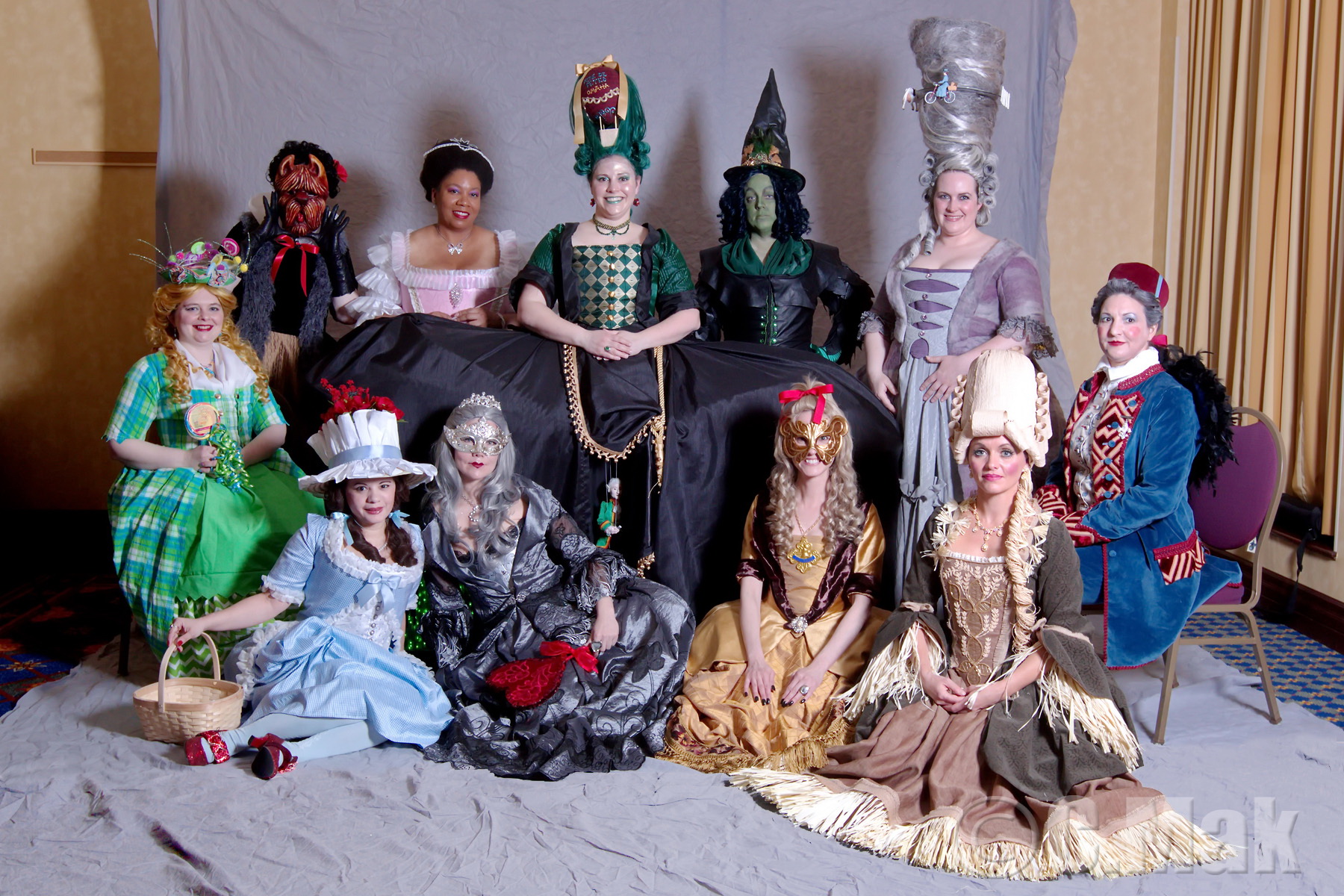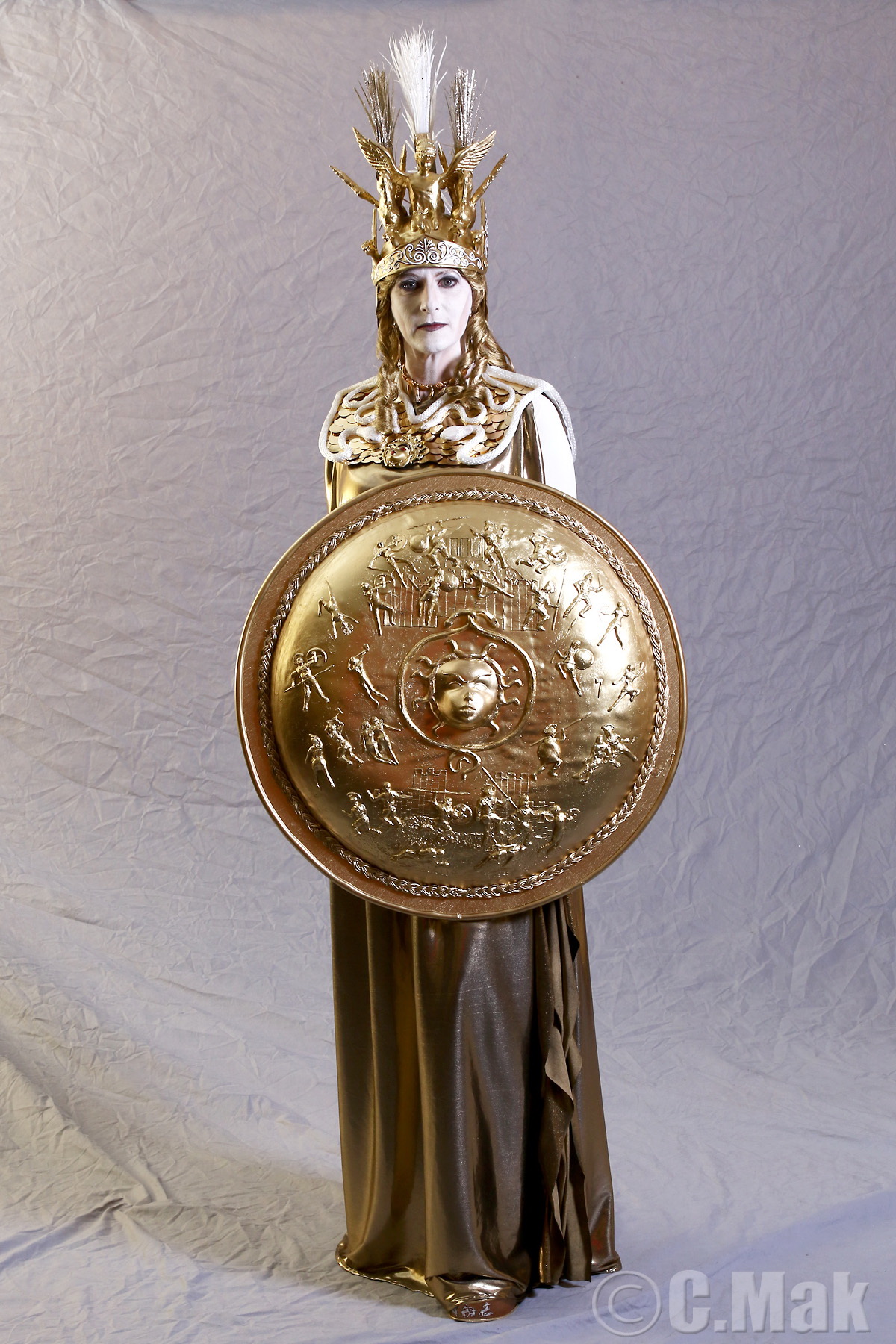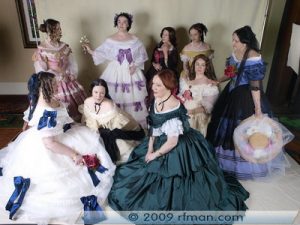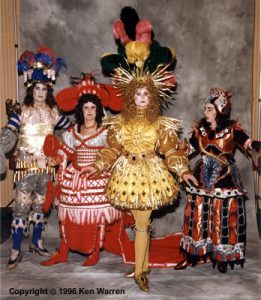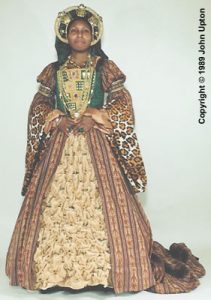CC32-H-31c: Athena Parthenos
CC32-H-31c: Athena Parthenos | Division: Master | Category: Historical Interpretation | Designer(s): Rae Bradbury-Enslin | Maker(s): Rae Bradbury-Enslin | Presenter(s): Rae Bradbury-Enslin | Workmanship Award(s): Best Master | Presentation Award(s): Best in Show - Overall | Documentation Award(s): Best Master (Photo ID: Christine Mak | Event Date: 2014)
Competition Staff & Rules
Staff:
- Director: Byron Connell
- Master of Ceremonies: Susan de Guardiola
- Presentation Judges: Toni Lay‡, Kevin Roche and Jacqueline M. Ward
- Judges’ Clerk: Unknown
Rules:
Historical Masquerade
Byron P. Connell, Director
Historical Masquerade Awards
| CATEGORY | PRESENTED BY | AWARD | |
| NOVICE DOCUMENTATION | |||
| The Exaltation of Inanna | Myths & Legends | Alyssa Kersting (Ishtar) and Emily Pittore (Enheduanna) | Tie — Best Novice |
| Timey-Wimey in B.L.U.E. | Historical Interpretation | Marni Samson | Tie — Best Novice |
| NOVICE WORKMANSHIP |
|||
| Timey-Wimey in B.L.U.E. | Historical Interpretation | Marni Samson | Best Novice |
| Cat Woman at the French Court | Historical Dress | Carol Cowan | Award for Overall Construction and Execution of Concept |
| The Exaltation of Inanna | Myths & Legends | Alyssa Kersting (Ishtar) and Emily Pittore (Enheduanna) | Award for Finishing — Myths and Legends |
| 14th Century Lady – Before | Historical Dress | Stephanie Strauss | Award for Finishing — Historical Dress |
| Peony Grass | Historical Interpretation | Claire McMillan | Best Embellishment (Thread Painting and Folded Ribbonwork) |
| Elizabethean Townswoman | Historical Dress | Jackie Wyatt | Best Needlework (sweets bag) |
| Showing Up the Queen | Historical Dress | Amy Leigh Miller | OCD Award for Applying Pearls Above and Beyond the Call of Duty |
| Female Version of Sherlock Holmes | Myths & Legends | Onyria | Best Hat |
| Pioneering Spirit – My Sunday Best | Historical Dress | Gypsy Girl (Carrie Clifton) | Award for Crocheted Lace |
| My Day Out | Historical Dress | Rachel Smith | Honourable Mention for Fascinator |
| Afternoon Stroll | Historical Dress | Silvia Fernandes | Award for Corset Crafting |
| NOVICE PRESENTATION |
|||
| Afternoon Stroll | Historical Dress | Silvia Fernandes | Best Novice |
| 1860 Day Dress | Historical Dress | Mary Parulski | Best Historical Dress |
| The Exaltation of Inanna | Myths & Legends | Alyssa Kersting (Ishtar) and Emily Pittore (Enheduanna) | Best Interpretation of Ancient Art |
| Showing Up the Queen | Historical Dress | Amy Leigh Miller | Most Striking |
| Timey-Wimey in B.L.U.E. | Historical Interpretation | Marni Samson | Best Time Machine |
| 14th Century Lady – Before | Historical Dress | Stephanie Strauss | Honourable Mention for Transformative Work |
| 14th Century Lady – After | Historical Interpretation | Jess Garver | Honourable Mention for Transformative Work |
| JOURNEYMAN DOCUMENTATION |
|||
| The Mrs. Astor 1890 Evening Gown | Historical Dress | Catherine Leeson | Best Journeyman |
| Bella Nani by Veronese | Historical Dress | Kathy Dwyer | Best — Historical Dress |
| Wisconsin Snow Queen | Myths & Legends | Catherine Cherwin | Best — Myths and Legends |
| Elizabeth I : The Virgin Queen | Historical Dress | Kathryn McPherson and Rick Ruzic | Honourable Mention for Prettiest Documentation |
| JOURNEYMAN WORKMANSHIP |
|||
| The Mrs. Astor 1890 Evening Gown | Historical Dress | Catherine Leeson | Best Journeyman |
| Wisconsin Snow Queen | Myths & Legends | Catherine Cherwin | Judges Choice for Sheer Joy of Concept |
| Bella Nani by Veronese | Historical Dress | Kathy Dwyer | Award for Jewelry Making |
| At the Homestead | Historical Dress | Sarah Bloy | Award for Authenticity — Especially for Embellishment |
| 1912 Afternoon Dress | Historical Dress | Margaret Decker | Award for Blouse Finishing |
| JOURNEYMAN PRESENTATION | |||
| At the Homestead | Historical Dress | Sarah Bloy | Best Journeyman |
| Wisconsin Snow Queen | Myths & Legends | Catherine Cherwin | Best Myths and Legends |
| The Mrs. Astor 1890 Evening Gown | Historical Dress | Catherine Leeson | Best Historical Dress |
| MASTER DOCUMENTATION |
|||
| Athena Parthenos | Historical Interpretation | Rae Bradbury-Enslin | Best Master |
| What to Watch? | Myths & Legends | Bethany Padron, Milo Martinez and Aurora Celeste | Best Myths and Legends |
| Star Attraction | Historical Dress | Mina Murray | Best Historical Dress |
| MASTER WORKMANSHIP |
|||
| Athena Parthenos | Historical Interpretation | Rae Bradbury-Enslin | Best Master |
| Miss Oz Pageant | Historical Interpretation | Jessica Frantal | Judges Choice, “You Blew Our Socks Off”: Tornado |
| The Difference 20 Years Makes | Historical Dress | Veegee’s Workshop | Award for Finishing and Use of Historical Tools & Techniques |
| Fasten Your Seatbelt | Historical Dress | K. Laplante, l. Fontaine, G. Côté, N. Savoie, A.M. Morin-Bédard | Most Uplifting for Foundation Garments |
| Miss Oz Pageant | Historical Interpretation | Laura Ulak | Award for Upcycling and Use of Leather |
| Miss Oz Pageant | Historical Interpretation | Samantha Evans | Award for Material Manipulation: Scarecrow |
| Apsaras and the Peasant | Myths & Legends | Vicki & Andrew Assarattanakul | Award for Jewelry Making |
| German Renaissance Historic Bell | Historical Dress | Michelle Gore | Special Recognition for Diversity of Techniques to Hilary Buckland (for entries 9, 10, 28) |
| What to Watch? | Myths & Legends | Bethany Padron, Milo Martinez and Aurora Celeste | Honourable Mention for Re-use of Vintage Fabrics |
| MASTER PRESENTATION | |||
| The Difference 20 Years Makes | Historical Dress | Veegee’s Workshop | Best Master |
| Star Attraction | Historical Dress | Mina Murray | The Minsky Award for Grace in Performance |
| Fasten Your Seatbelt | Historical Dress | K. Laplante, l. Fontaine, G. Côté, N. Savoie, A.M. Morin-Bédard | The “Fly Me!” Award for Perfect Nostalgia |
| What to Watch? | Myths & Legends | Bethany Padron, Milo Martinez and Aurora Celeste | Honourable Mention for Creeping Their Way Into Our Living Rooms |
Rules for the Historical Masquerade
1. The Costume-Con 32 Historical Masquerade celebrates the history of costume, including all cultures, periods, and types of dress. It recognizes creativity, scholarship, stage presentation, and workmanship skills in the context of historical clothing.
2. “Historical costume” is costume based on clothing that was worn or could have been worn somewhere in the world through the end of December 1980.
3. These rules for the Historical Masquerade follow the International Costumers’ Guild Guidelines for Ensuring Fair Competition. Please read therm carefully; while similar to those for other masquerades, they are not identical to them.
4. To enter the Historical Masquerade you must be a member of Costume-Con 32, as must any models you may plan to use.
5. Masquerade Entrants Registration. All entries are encouraged to use the registration form on our Web site to pre-register. There will be at-the-con registration, but pre-register even if you only think you’ll have a garment completed in time. You will be able to update or change information until the on-site historical masquerade registration desk closes. Each entrant is asked to circle the appropriate date of the costume on the Registration Form (Time Period). If each costume in a group entry has a different time period, circle the appropriate dates. At the con, entrants must check in at the historical masquerade registration desk (so we know you’re here). Each entrant (in a group, every member who will be on stage) will sign a masquerade release form.
Registration forms can be submitted to the Masquerade Director.
Competition Categories
6. The Historical Masquerade will have four categories of entry:
A. Myths and Legends (including Monsters)
B. Historical Dress,
C. Historical Interpretation, and
D. Ethnic Costume or Dress.
Entries in all categories are eligible for Best in Class and Best in Show.
7. Category Definitions:
A. Myths and Legends (including Monsters) is for a costume or a group of costumes reproducing or interpreting costumes from, or inspired by, mythology or folklore worldwide. These include, but need not be limited to, costumes from stage productions, films, television, Japanese media, graphic novels, or paintings produced or released no later than the end of December 1980. We plan to make special awards for entries in this category.
B. Historical Dress is for a costume that is intended to look like it came from a particular period of history. This includes costumes copied from a specific artwork or surviving garment, original costumes meant to look as if they were designed and made in a particular period, and everything in between. It is acceptable to use modern approximates for period materials for reasons of availability, cost, or safety; these approximations should be noted in documentation. Modern machine sewing is allowed.
C. Historical Interpretation is for a costume that intentionally and visibly departs from the period on which it is based. It ought to be obvious to the viewer that this costume was not intended to be totally authentic. If the judges have to ask what makes your costume an interpretation, it probably belongs in Historical Dress.
The distinction between these two categories is based on the costume’s intent, not its execution.
D. Ethnic Costume or Dress may be of any period (including the present). Ethnic means “of or pertaining to a religious, racial, national, or cultural group.” Any costume that would fall into any religious, racial, national, or cultural group may be entered as Ethnic Costume or Dress. If an ethnic garment is from the past and no longer worn by any of the above-listed groups under the definition of Ethnic, the entry may still be considered Ethnic Costume. This category is one of reproduction, NOT interpretation. Therefore, your requirements for design and creation techniques (e.g., sewing), choices of materials, and documentation will be the same as Historical Dress entries.
Skill Levels
8. Skill Level Definitions: Skill levels are intended to ensure that both novice and experienced costumers have a reasonably equal chance to win awards.
A. Young Fan: This level is limited to entrants younger than 13 years of age on April 27, 2014 (i.e., born after April 27, 2001) who are no part of an adult entry. It will be divided between entries made by a young fan and entries made by an adult that a young fan presents.
B. Novice: The Novice level is to encourage beginners. You may not enter at this level if you (1) have won two awards at the Novice level in a Costume-Con historical masquerade, (2) have won at a level higher than Novice in a Costume-Con historical masquerade, (3) compete at the Master level in science fiction and fantasy masquerades at Costume-Cons, Animé North, or World Science Fiction Conventions (ICG-recognized “international-level competitions”), (4) have a costume Laurel, or (5) are a professional. Professional is defined as someone who earns a majority of his or her income from fashion or costume, including university faculty members.
C. Journeyman: The Journeyman level is an intermediate level to allow further development of costuming skills. You may not enter at this level if, at a Costume-Con historical masquerade, you (1) have won four awards at the Journeyman level, (2) have won an award at the Master level, (3) have won Best in Show, or if you (4) have a costume Laurel or (5) are a historic costume professional (as defined above).
D. Master: This is an open level. Anyone may enter. You must enter at this level if you are not eligible to enter as a Young Fan or at the Novice or Journeyman levels.
Group entries should compete at the level of the group’s most experienced member who is an essential element of the entry. If in doubt, consult the Masquerade Director.
9. A contestant may enter at a level higher than the one for which he or she qualifies. However, an entrant who then wins at that level may not subsequently compete at a lower level. If in doubt over the level at which to compete, consult the Director.
Awards
In honor of the late Marty Gear, Costume-Con 32′s co-chair, the best in show award will be named the Marty Gear Best in Show Award.
10. Our judges will make awards in three areas: A. Documentation, B. Workmanship and Detail, and C. Stage Presentation. In each area, Myths and Legends (including Monsters) is a separate entry category. The Historical Masquerade’s philosophy is “excellence deserves award”; there are no predetermined minimum or maximum number of awards the judges may make. Entries will be judged against what the judges see as the award-winning standard; this means that you will not be competing against anyone else. The judges are not obliged to award Best in Class or Best in Show if, in their opinion, no entry meets the standards for those awards.
11. When the person wearing a costume is not its designer/maker, awards recognizing design, creation, or workmanship will be made to the designer/maker, not the wearer.
A. Documentation: Every entry must have some documentation. Documentation must be turned in to the masquerade registration desk by 8:00 p.m., April 25, 2014. If you are arriving at the con later, please contact me well in advance.
i. Basic documentation. The basic requirements include:
a. Title of costume
b. Entry category
c. Name and address of the person responsible for the entry (or spokesperson for a group)
d. Name(s) of designer(s) and maker(s)
e. Brief identifying description of the costume’s historical period, geographic origin, social class, and so forth
f. Bibliography of sources
The “brief identifying description” should include evidence of the historical basis for the costume. This could be as little as one photocopy of a single picture with an identifying caption or it could be more comprehensive. Assume that the judges are not familiar with the costume(s). You may wish to begin with a brief statement of what you are trying to accomplish and your rationale for choosing the project.
ii. Advanced documentation. In going beyond the minimal requirements, your documentation might include the following:
- Pattern sources
- Photocopies of visual sources, such as artworks, costume drawings, and sketches, that you used
- Rationale for design and for choices of fabrics and colors
- Swatches of fabric and trim
- Your own photograph(s) of original historical garments or accessories
- Brief descriptions of any special skills or tools you used, such as shoemaking, weaving, or welding
iii. Good documentation (Basic or Advanced). Outstanding documentation demonstrates a comprehensive knowledge of the historical source(s) on which a costume is based, with rationales for all elements of the costume, including undergarments, accessories, and minor details, and explanations for deviations from the norm of the period. Excellent documentation also is organized logically and neatly, and presented attractively. Some contestants even go to the length of designing documentation in a style consistent with the costume.
iv. Length of documentation. Outstanding documentation is brief – long enough but no longer than you need to demonstrate the historical basis of the costume. Please be concise. Text (exclusive of bibliography and captions on illustrations) is limited to no more than five 8½”x11” typed double-spaced pages per costume. (In a group entry, each costume may have up to five pages of text.) There is no page limit on captioned photographs and illustrations, fabric swatches or other samples, references, or bibliography. A caption need not be limited to only a few words. It may be a few sentences or even a brief paragraph.
v. The following will not be accepted as a part of documentation: original sources, including books and paintings (make copies), slides, computer files, and videos (tape/CD/DVD).
B. Workmanship and Detail Judging (“Pre-judging”): This is your opportunity to let the judges admire your work up close. Each entry will meet by itself with the panel of judges to show off the costume. Entrants will be expected to show the judges all necessary parts of the costume. If there is an item or element of the costume you want the judges to note especially, be prepared to point it out to them. We recommend that you bring the costume to the prejudging, rather than wear it, so that the judges may handle and examine your work inside and out. However, if you decide to wear the costume to prejudging, be prepared to have the judges look down your cleavage, under your skirt, or at your underwear.
This part of the competition is required of all entrants. Prejudging time will be strictly limited. While we will not know what the time limit will be until the con, it probably will be about five minutes and certainly no more than ten minutes per person. The schedule will depend on the number of entries received by close of registration. Contestants will have an opportunity to sign up in advance at the masquerade registration desk for appointments with the judges.
C. Stage Presentation: Here is your opportunity to complete your illusion before an appreciative audience and the judges. Entries with one to six persons will be limited to a maximum of 60 seconds on stage. Entries with seven or more persons will be allowed up to 90 seconds. Please keep in mind that these are maximum, not minimum, lengths of presentation. If you feel that the maximum allowed will not be enough time to show your presentation, the Masquerade Director will be willing to listen to your argument and possibly allow more time, but that is in his discretion. The Masquerade Director strongly believes in brief presentations – 30 seconds normally should be sufficient to present a one-person entry to the judges and the audience.
Constraints on Presentations
All the general stage presentation rules for Costume-Con 32 masquerades will apply.
Safety: Safety is our paramount concern. There will be absolutely no flame, fires, sparks, or other flaming on stage. Other special effects must be clearly described to the Masquerade Director and to the stage manager and tech crew at the tech rehearsal in order for us to determine that they are (1) legal and (2) safe. Strobe lighting, for example, has the potential to be harmful to members of the audience. Smoke or fog machines could set off the fire alarms.
Weapons: If your entry includes displaying a weapon, the Masquerade Director must clear it and your routine ahead of time in order to ascertain that it will not harm other entrants, the judges, or the audience. No sharp edges or points will be permitted. Weapons must be carried to and from the Green Room in secure wrappings and must be peace bonded. Weapons that shoot or eject projectiles will not be permitted. If you intend to point a weapon at other members of your entry or at the judges or audience, you must demonstrate in advance to the Masquerade Director that the weapon DOES NOT WORK.
Entrants may not throw anything at the audience.
Recorded Material: Music and/or narration or dialogue as part of your presentation must be pre-recorded (except for a script to be read by the MC). Provide your recordings on CD or CD-R (not CD-RW), or as a file on a USB drive. We cannot accept tape cassettes. Two copies must be handed in at the masquerade registration desk as early as possible so that the tech crew can program sound for the show. The copies should contain only the music and/or speech you want played AND NOTHING ELSE; please do not provide a commercial CD and ask us to play a specific band. We strongly recommend that you bring several copies of your recording, to provide a back-up should one fail. We also suggest bringing copies in more than one medium (e.g., a CD to back up a USB drive), just in case. Label your recordings with the entry title and your name. We do not plan to return them after the show, so please do not turn in anything of continuing value.
No Live Microphone: There will be no microphones available to entrants; the only person permitted to speak from the stage is the Master of Ceremonies (MC). The MC will be happy to work with you in reading a short script or to interact with you during your presentation; remember, however, that you have only one minute on stage. The MC will have only a small light on the podium under which to read scripts. Please provide your script in black double-spaced type on white paper using at least 18-point letters in a plain and easy-to-read font. Put the title of your entry and your name at the top of the script. Please keep a script for the MC to no more than about 100 words.
Other Constraints: Entrants may not use substances, including make-up or costume elements, that could turn rancid or be smeared on or stain other costumes. All parts of your costumes must leave with you. This is generally known as the “No Peanut Butter” rule.
Each contestant may appear only once on stage. You may enter another costume, but it must be on another Costume-Con 32 member’s body.
Costumes with electric power requirements must be self-contained – no extension cords.
We discourage the use of radio controlled or other wireless devices as part of an entry. We do not know what sort of interference will exist in the hall during the show. It would be unfortunate to base your entry on something that doesn’t work when you are on stage.
The historical masquerade is rated PG-13; there may be children in the audience. No flagrant nudity — there must be some display of skill in creating and executing a design. The Judges will not award what Mother Nature created. Remember, no costume is no costume.
No live animals (other than guide animals) may be used in the masquerade.
Small children must be under the control of a responsible adult at all times (back stage as well as on stage).
Costumes that have won major awards (excluding Honorable Mention) for presentation or workmanship at previous Animé North, Costume-Con, or Worldcon competitions are ineligible to compete for an award, but may appear Out of Competition. Commercially made costumes, purchased or rented, may be shown only Out of Competition.
Your costume must be completed before you get to the Green Room. No sewing, gluing, soldering, welding, or other construction work may take place in the Green Room except the final assembly of large costumes and props or unexpected repairs.
Following a presentation, the entrant(s), roadies, or ninjas must remove props left on stage in a single pass.
No Constraint on Hall Costumes: There is no prohibition against presenting costumes worn in the halls before the show.
Tech Rehearsal: Entrants will be required to attend a tech rehearsal. This is an opportunity for the stage manager and the tech crew to work with you to assure that sound and lighting support your presentation. Entrants who do not participate in the tech rehearsal may not appear in the masquerade. You need not wear costumes for the tech rehearsal; however, you should wear the shoes you will use for your presentation and any parts of your costume that will impede your movement or vision, or both. Please bring a part of the costume that represents its dominant color(s) for a lighting check.
The default lighting (“Fred”) will be stage dark, lights rise on entry, fade to black at exit; other patterns may be arranged with tech.
Green Room: Come to the Green Room when it opens officially (probably two hours before curtain time). Check in with the person at the check-in table. You will learn your number in the running order and will be assigned to a den of entries just before and/or after you, where you will be in the care of a Den Mom. Go to your den, introduce yourself to the Den Mom assigned to you, and take a seat. Please stay there until it is time to go on stage.
If you need anything, let the Den Mom assigned to you know. We plan to provide light refreshments and to have a manned repair table should a costume need repairs. The repair table provides glue, safety pins, needles and thread, tools, basic makeup, and so forth. It is for last-minute repairs, not for building or completing a costume.
Your Den Mom will see that your photo is taken by the official masquerade photographer and the photographer taking reference photos for the judges. We expect that official photos will be available for purchase by you and other convention members, possibly the next day. Your Den Mom also will get you to the stage at the right time and in the correct order.
The Green Room and back stage area are intended for entrants, roadies, and masquerade staff only. Entrants are asked not to invite other friends or family into the Green Room.
Stage Assistance: Back stage, there will be stage “ninjas” (dressed in black) at the wings to help you up and down the stairs, move props on and off stage, and catch you if you stumble. You need to let us know how much assistance you need, especially if your vision is obscured by a mask or by not wearing your glasses, or if your costume limits your range of movement. The more assistance you need, the earlier you should let us know (preferably at the masquerade registration desk).
There also will be stage ninjas at the front and sides of the stage to try to stop you from stepping off the stage by mistake. If you hear someone shout “Stop!” during your presentation, do so; you are in immediate danger of falling off the stage! However, if you dance, run, hop, skip, or jump so fast that the catchers cannot stop you, you are responsible for your own safety.
Never Surprise the Crew: Entrants should surprise the audience. NEVER surprise the Masquerade Director, the MC, the Tech Director and crew, and the stage crew. No exceptions to the “never surprise the crew” rule will be permitted and entrants who attempt to do so will be disqualified. If you are planning something unusual or unique, please inform the Masquerade Director well in advance of the masquerade.
Other Grounds for Disqualification: The Masquerade Director has the full authority to eliminate anyone from the competition on the grounds of bad taste, danger to self and/or others, violation of the above rules, or any other reason deemed sufficient. There is no appeal. Offers of cash and/or chocolate will not help.
Photography:
Official Photography: The official masquerade photographer will photograph your costume(s) before the show starts. This is not optional.
Fan Photography: Fan photography may take place from the audience during the show, using available light (not flash). For the safety of those on stage, use of flash photography from the audience during the show is strictly prohibited. The Masquerade Director will stop the show and have the house lights turned on until those using flash have been ejected from the hall. In addition there probably will be an on-stage “photo run” for fan photographers after the last entry’s presentation (while the judges are deliberating); if so, your participation would be optional.
If you feel any or all of these rules don’t apply to you, you are wrong. You must convince the Masquerade Director to make an exception long before the masquerade. Offers of cash and/or chocolate will not help here either.
Tips for a Successful Masquerade
Before the show, get some sleep!
Before the show, please eat. If you want to faint after you’ve been on stage, fine; however, we don’t want you to pass out from hunger or low blood sugar in the Green Room or on stage.
Before the show, rehearse, rehearse, rehearse.
Remember, this is a costume show, not a talent competition. Never bore the audience.
Don’t forget to enjoy yourself. Have fun!
If you have any questions, please contact the director at [Removed].
Byron Connell
Historical Masquerade Director
Costume-Con 32
—
Historical Masquerade
The Historical Masquerade will have four categories of entry:
A. Myths and Legends (including Monsters)
B. Historical Dress,
C. Historical Interpretation
D. Ethnic Costume or Dress.
The Historical Masquerade has some additional requirements: You must submit documentation when you check in at the convention (you can do this at the same time as you provide your music/soundtrack). Keep in mind that the documentation doesn’t have to be a thesis; you want to at least show some evidence that you researched your subject, some photos showing either your design process or the original reference, some explanation of your process and choices, and some progress photos. You can make it fancier, maybe tying the format of the documentation into the theme of your costume (some people do, as there is a separate award for best documentation) but it’s not obligatory.
Some examples of documentation to get you started:
- Example from a Virtual Costumers newsletter, about an entry from the CC 28 masquerade.
- Example of Documentation from CC31.
- Tips on Basic Documentation from Dramatic Threads
- Example of Documentation from a CC22 entry
- Example of Documentation from CC30
You must also make an appointment for your workmanship judging. Historical workmanship judging is done the day before the Historical Masquerade (during the day Saturday) and you will meet with the judges for approximately 5-10 minutes. Costumes are usually shown to the judges flat or on hangers (not worn) for the Historical workmanship judging.
The Historical masquerade will be Sunday evening.
More details are available here: [Removed]
